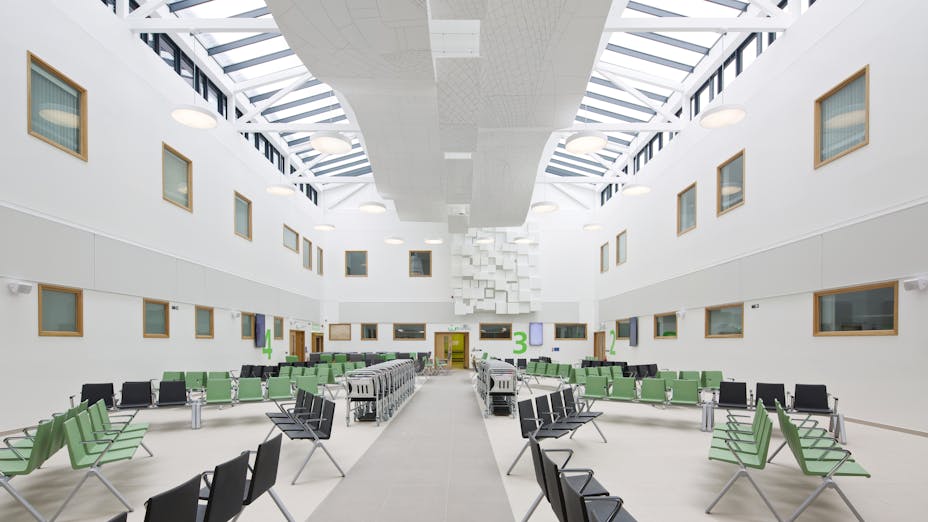What Does Biophilic Design Mean in Health Centres?
Several studies have found that the biophilic design reduces anxiety and so increases sleep. But how did that conclusion come to be? To get there, you must first grasp the advantages of having a biophilic design in hospitals and health care facilities:
- Good ventilation means less infectious illness spread, and fresh air reduces stress.
- Sound-absorbing materials minimise noise levels, reduce distractions and errors, and reduce tiredness in both personnel and patients.
- As previously said, optimising natural light reduces hospital stays as well as pain, depression, weariness, and the need for medicine.
- When you have a connection to nature or natural elements, your emotional well-being skyrockets.
- Indoor gardens encourage more social contact.
- The use of natural materials improves the comfort and pleasantness of the sanitary environment.

What Does Biophilic Design Consist Of?
There are various aspects to biophilic design, beginning with the genuine presence of nature in a room. Living plants, view and sound of moving water, and other sensory cues offer patients with direct environmental interconnections. Employees also work better when they have access to the outdoors via a garden or sunroom.
Natural analogues are also important because they provide indirect connections to the outside world via substance and colour. Natural building materials, such as wood or granite, with visible texture and grain, should be used in hospitals. Nature-themed paintings and wall hangings also achieve the intended impact. This tactile method reduces stress and improves well-being in both patients and caregivers.

Finally, the nature of the space is critical. What can patients see beyond their immediate surroundings or outside the window? Poor architecture that limits visual exposure to the outdoors reduces recovery rates and increases staff churn. Patients who have greater visual access to natural light and outdoor spaces, on the other hand, have fewer issues, and those who care for them are also happier.
In 1984, Dr. Roger Ulrich noticed that patients in hospital rooms with views of nature and water recovered faster than those who stared at a brick wall all day. The nature group used fewer medicines, had fewer unfavourable remarks from nurses, and was discharged faster than the wall group.
However, given that three decades of research have supported Ulrich's claim, it's surprising that more hospitals haven't embraced biophilic design concepts.
The Significance of Natural Light on Patient Health
When we enter a hospital, one of the last things we think about is how lighting may aid enhance cleaning, hygiene, and sanitation, as well as boost the spirits of both staff and patients.
Natural light is very important in the medical industry for staff efficiency, cleanliness, and patient well-being.
The Negative Effects of Artificial Lighting
Artificial lighting advancements have enabled architects to develop larger and deeper buildings with numerous enclosed regions that do not rely on natural lighting for illumination at all. While these locations are habitable, they can have a detrimental impact on general well-being and productivity, as well as a lack of efficiency.
Patients in windowless rooms frequently report increased levels of stress and, in some extreme circumstances, may be affected by Sick Building Syndrome (SBS).
The Benefits of Natural Light in Hospitals
Natural light and views from windows, on the other hand, can provide health benefits to both patients and hospital staff:
Shorten the duration of in-patient stays
According to studies, patients admitted to brighter rooms spend up to 41% less time in the hospital than those assigned to darker or windowless rooms [4]. Patients in darker rooms had a higher mortality rate.
Accelerate post-operative recovery
Patients recovering from surgery who are in rooms with lots of natural light and good views are less anxious and have lower blood pressure, which is critical for healing. Patients in windowless rooms, on the other hand, are more likely to experience depression and suffer postoperative delirium. This can cause an increase in inflammation in the body, which increases pain and makes healing more difficult.
Contribute to more effective pain alleviation
Approximately 22% of patients in bright, natural light rooms use fewer pain medications. While pain medication is required in every hospital, patients who require more pain medication must cope with any undesirable side effects as well as increased medical expenditures while recovering.
Boost employee morale
Employee attitudes and productivity are improved by natural illumination. It has been demonstrated to boost staff energy levels. Employees in a hospital with access to natural light and views of nature report lower stress levels and health-related absenteeism.
What are the Natural Lighting Levels Suitable for Hospitals?
When it comes to building hospitals and other health care facilities, the most essential elements for window design are the amount of daylight that enters a space, the view, patient privacy, and closeness to the window. Patients generally prefer windows that take up at least 25% of an exterior wall, with many choosing rooms with two or more windows.
Furthermore, multiple studies have found that strong lights (at least 2,500 lux) with short white or blue wavelengths are the most useful to patients. This is especially true for Alzheimer's or dementia patients, who have been proven to have less agitation later in the day and better sleep-wake cycles.

Hospitals can also utilise our smooth, deep matt, super white sound-absorbing ceiling tiles like Rockfon® Mono® Acoustic and Rockfon Blanka® which have 87% light reflection and more than 99% light diffusion. These products not only offer excellent sound absorption but also contributes to energy savings and a bright and comfortable indoor environment.
Furthermore, skylights are an excellent choice for hospital architecture. They provide constant natural light while displaying vivid vistas throughout the day. Skylights, because they are located on the roof, provide all of the benefits of a vertical window with the extra benefit of privacy.
Conclusions on Biophilic Hospital Design
The truth is that a shift is occurring in the architecture of healthcare facilities. Without taking a back seat, functionality has given way to the patient and their well-being. The biophilic design is one of the most useful and easy measures with a superior cost-benefit ratio for doing this. It also conveys a strong statement about your social consciousness and green credibility, as well as your concern for others.
A well-distributed setting with fresh air, a good proportion of outside exposures, and sufficient natural lighting improve the health of patients and healthcare professionals.
---
Sources:
(1) "The Economics Of Biophilia". 2022. Terrapinbrightgreen.Com. https://www.terrapinbrightgreen.com/reports/the-economics-of-biophilia/.
(2) Park, Man Young, Choul-Gyun Chai, Hae-Kyung Lee, Hani Moon, and Jai Sung Noh. “The Effects of Natural Daylight on Length of Hospital Stay.” Environmental health insights. SAGE Publications, December 3, 2018. https://www.ncbi.nlm.nih.gov/pmc/articles/PMC6287302/.
(3) "Urbanization By Continent 2021 | Statista". 2022. Statista. https://www.statista.com/statistics/270860/urbanization-by-continent/.
(4) "Impact Of Light On Outcomes In Healthcare Settings". 2022. The Center For Health Design. https://www.healthdesign.org/chd/research/impact-light-outcomes-healthcare-settings.






